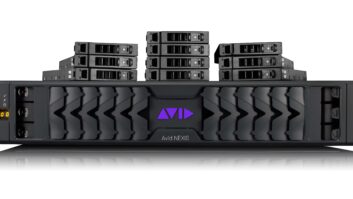
Big data can lead to big concerns over storage, bandwidth, and reliability. 4K produces a huge amount of data. For example, RED states that its RAW 4K 12-bit video at 24fps produces 324MBps (2.5Gbps), although its REDCODE RAW compression can reduce this to about 28MBps (224Mbps).
“There’s so much confusion about 4K data rates, formats and codecs, that selecting the storage with the appropriate capacity, performance and price point can be a daunting prospect for broadcasters and production companies. To date, much of the post industry has adopted a proxy-based approach to 4K post production, fearing that their central storage, network and client workstations cannot cope with the high bandwidth required for online editing,” explained Ben Pearce, sales and marketing director, GB Labs (pictured).
“It is true that 16-bit 4K RAW files are tremendously taxing on hardware. But 40Gb Ethernet combined with GB Labs SSD storage can manage full 4K – in fact ours have been successfully tested with 8K material,” he added.
As UHD production increases, predicting storage capacity requirements for the next two to three years will be difficult. “Users do not want to be locked into expensive storage that can only meet short-term needs,” which is why, he said, GB Labs has focused on making its systems fully scalable and easily expandable from the outset.
“When it comes to graphics houses and film production, the needs are clear. On the film set we know that ARRI and RED shooters will typically shoot RAW so our new SSD DIT cart is already serving a mature market. The 4K Space Duo product is based on high speed disks and as data security is vital on set, the system incorporates dual LTO-6 drives that can back files up at 320MBps.”
Some of GB Labs customers are already going beyond 4K. Crystal CG had to supply thousands of motion graphics in resolutions up to and beyond 4K for the London 2012 Olympics. “Its 80 creatives needed simultaneous access to the storage, so we installed a 28.8TB system that could sustain in excess of 6000MBps. The scale, time-sensitivity and importance of the Olympics meant a no-compromise, all-SSD approach,” he explained.
Other customers include Thomson Reuters and the BBC, but few broadcasters have so far done much with 4K, and Pearce says that of those that are “many are taking a more considered approach, using small, very high speed SSD arrays – such as the 2,000MBps 9.6TB Midi Space SSD – for online editing, but offloading files and projects onto HDD-based RAID storage for nearline archive. Alternatively they are adopting a conservative, proxy-based workflow. Few beyond broadcasters in the Far East are currently investing in 4K infrastructures,” although he believes that developments GB Labs will announce in the next few months could change that.
When it comes to full life-cycle data management, he maintains that the new generation of network attached storage will deliver very high speed volumes in excess of a Petabyte, support for mixed OS workgroups and Ethernet connectivity at up to 56Gbps. Configured with expansion units, users will automatically back up or offload 4K files onto tier 1 systems such as GB Labs Space, which can provide 384TB of very high speed primary storage.
“In a fully 4K environment, the role of a traditional nearline archive changes somewhat,” he added. “Our own tier 2 Space Echo offers very scalable, low-cost storage. In an HD environment, this type of storage can handle the play back of multiple streams of low compression HD files. With 4K broadcast-ready clips, existing nearline may be unable to fulfil this function, being limited to the role of a secure, instant availability deep archive.”
Cluster Head
GB Labs has just introduced a clustered Multi-Petabyte storage system with no single point of failure that should be suitable as a massive (up to 30 petabytes) nearline system for broadcasters, archives and content owners.
Cluster Head is a secure, scalable data silo that should provide archivists and others with instant access to media files over standard Ethernet networks. It is configured as a tier 1 online platform, and has the power to deliver excellent 4K speed, so that large workgroups can collaborate on editing projects.
Data is safeguarded to a very high degree. RAID 5 and RAID 6 protection secures each storage node and each storage cluster respectively, and the system, equipped with 10GbE and 40GbE connectivity, supports realtime data replication between multiple clusters of storage.
“For global content owners, 24/7 availability is critical and any data loss whatsoever is unthinkable,” said Pearce. Cluster Head “is incredibly well protected with the option of realtime backup and data synchronisation. Despite this focus on security, it makes no sacrifice in terms of performance, scalability and usability,” he claimed.
With data protected at the node and cluster under RAID 65, Cluster Head has high fault tolerance. By installing multiple clusters, entire storage nodes can be kept for parity to safeguard against any node failure.
The systems ship with the company’s Heart Beat software that constantly analyses each node to warn of imminent or actual system or storage issues. For file management, they are compatible with such media asset management tools as Cantemo Portal, Metus MAM and CatDV. The storage supports mixed OS environments and various NLE software packages, including Avid Media Composer, Adobe Premiere Pro, Grass Valley Edius Pro and Apple Final Cut Pro.
By David Fox
www.gblabs.com







